Native plant borders support local pollinators when you select at least 26 species with staggered bloom times from spring through fall. Create multi-layered structures with varying heights and cluster plants in groups of 3-5 for visibility. Include natural nesting sites like bare soil patches, hollow stems, and bee hotels near flowering plants. Maintain your border chemical-free by introducing beneficial insects and using organic mulch. Your thoughtfully designed border can transform even small spaces into thriving pollinator havens.
Understanding Your Local Pollinator Ecosystem
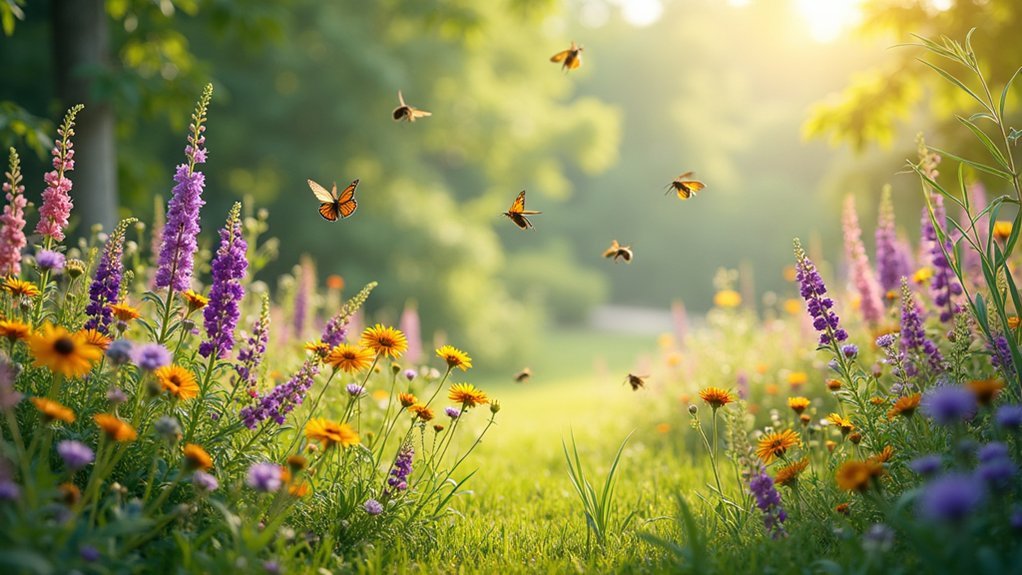
While many gardeners focus primarily on plant selection, truly successful pollinator gardens begin with understanding the complex web of life in your local area.
Your garden isn’t just a collection of plants—it’s a habitat for diverse pollinators like bees, butterflies, bats, and specialized flies that each fulfill unique ecological roles.
A garden is an ecosystem—a living sanctuary where countless winged allies maintain nature’s delicate balance.
Native plants form the foundation of these relationships, with many pollinators having evolved alongside specific plant species.
Consider the monarch butterfly, which exclusively needs milkweed to complete its lifecycle. By incorporating native plants that bloom at different times, you’ll provide year-round sustenance for local pollinators.
Reconsider what you might label as “undesirable” insects—many play beneficial roles in your garden’s ecosystem and contribute to its overall health and productivity.
Selecting Native Plants for Continuous Blooming
Creating a successful pollinator garden hinges on selecting native plants that provide food throughout the entire growing season. Aim for diversity with at least 26 different native species that bloom in succession from early spring to late fall, establishing a continuous food source for bees, butterflies, and other beneficial insects.
Choose early bloomers like crocus to welcome the first pollinators, then shift to summer favorites such as coneflowers and bee balm with their accessible, open blossoms.
Complete your seasonal palette with late-season options like goldenrod to sustain pollinators preparing for winter.
Select plants that serve dual purposes—milkweed not only provides nectar but also hosts Monarch caterpillars.
Pay attention to which plants attract the most activity in your yard and adjust your selections accordingly.
Creating Multi-Layered Border Structures
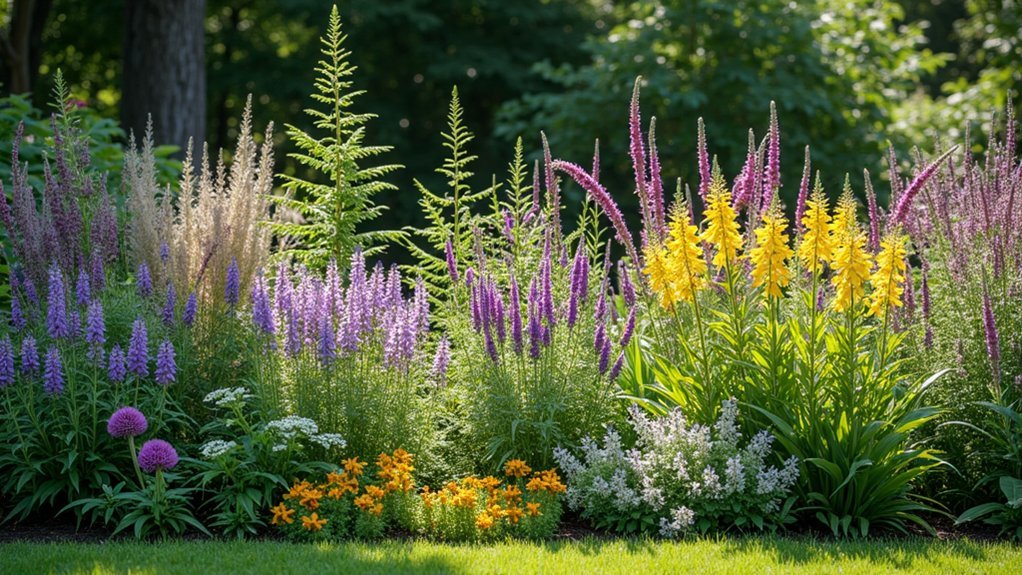
Successful pollinator borders depend on thoughtful vertical structuring, where plants of varying heights work together to create a thriving ecosystem. Your border design should mimic natural landscapes by incorporating tall background elements, mid-height native flowers, and low-growing groundcovers.
- Position flowering shrubs and small trees at the back to provide nesting sites while creating a protective windbreak for smaller pollinators.
- Plant native flowers in clusters of 3-5 plants rather than individual specimens to increase visibility and attraction power.
- Incorporate rocks, logs, or bee hotels between plantings to create additional habitat niches.
- Select species with staggered bloom times from spring through fall to guarantee continuous food sources.
This layered approach maximizes biodiversity in a limited space, creating a complete habitat that supports pollinators throughout their entire life cycles.
Establishing Natural Nesting Sites Within Borders
Beyond food sources, successful pollinator borders must provide safe nesting opportunities to complete the habitat cycle. Create dedicated nesting areas by incorporating bundles of hollow stems, twigs, and patches of unmulched bare soil along your border edges. Many solitary bees specifically seek these materials for their homes.
Don’t overlook the importance of undisturbed spaces within your design. Native bumblebees frequently nest in abandoned rodent burrows or beneath leaf litter.
For additional habitat diversity, install bee hotels using untreated wood and hollow tubes, which accommodate various solitary bee species with specific nesting requirements.
Position these nesting areas near native flowering plants like sunflowers and coneflowers to create a complete ecosystem. The diverse plant selection in your border not only feeds pollinators but supports their full lifecycle by meeting their unique habitat needs.
Designing for Seasonal Transitions

You’ll want to plan your native plant border with a strategic progression from spring ephemerals like crocuses through summer stalwarts such as coneflowers, creating an uninterrupted nectar calendar.
Support fall pollinators by incorporating late-blooming asters and goldenrod, which provide vital resources for migrating butterflies and bees preparing for winter.
Don’t overlook winter’s importance—leave seed heads standing and incorporate evergreen natives that offer both shelter for overwintering insects and structural interest during dormant months.
Spring-to-Summer Flowering Sequences
While creating a pollinator-friendly garden often focuses on plant selection, thoughtful planning of bloom times transforms a simple collection of natives into a dynamic, season-spanning buffet for bees, butterflies, and other beneficial insects.
To create continuous nectar and pollen sources throughout the growing season:
- Start with early bloomers like crocus and spring ephemerals to welcome emerging pollinators.
- Shift to mid-summer workhorses such as coneflowers and black-eyed Susans during peak activity periods.
- Include at least 26 native species with staggered blooming schedules for ideal support.
- Finish with late-season plants like asters and goldenrods to fuel fall migration and winter preparation.
Regularly monitor your garden’s flowering patterns and adjust your planting strategy to maintain continuous bloom coverage as seasonal conditions change.
Fall Migration Support
As summer’s abundance begins to wane, your garden can become a essential lifeline for migrating pollinators seeking energy sources for their long journeys south. Incorporate late-blooming native species like goldenrod and asters, which provide abundant nectar just when monarchs and other migrants need it most.
| Season Stage | Pollinator Need | Your Garden’s Role |
|---|---|---|
| Early Fall | Rich nectar sources | Fuel for the journey ahead |
| Mid-Fall | Accessible pollen | Final protein boost before winter |
| Late Fall | Reliable food stops | fundamental survival support |
Plan for staggered bloom times to guarantee continuous nectar availability throughout the migration period. You’ll not only support pollinators’ immediate energy needs but also contribute to their successful journeys. Remember that native plants producing seeds in fall additionally support birds, creating a balanced ecosystem during this essential shifting season.
Winter Structure Planning
The garden’s quieter months demand thoughtful preparation to guarantee your native plant borders continue supporting pollinators year-round.
Design your winter landscape to provide shelter and sustenance for native pollinators when resources are scarce.
- Leave dried flower stalks and seed heads standing to offer food sources and protective nesting sites
- Create varying heights and forms throughout your border to accommodate different pollinator needs
- Incorporate brush piles and preserve snags (dead trees) as natural habitat structures
- Plan for early-blooming native plants that will nourish emerging pollinators before spring fully arrives
Incorporating Host Plants for Butterfly Species
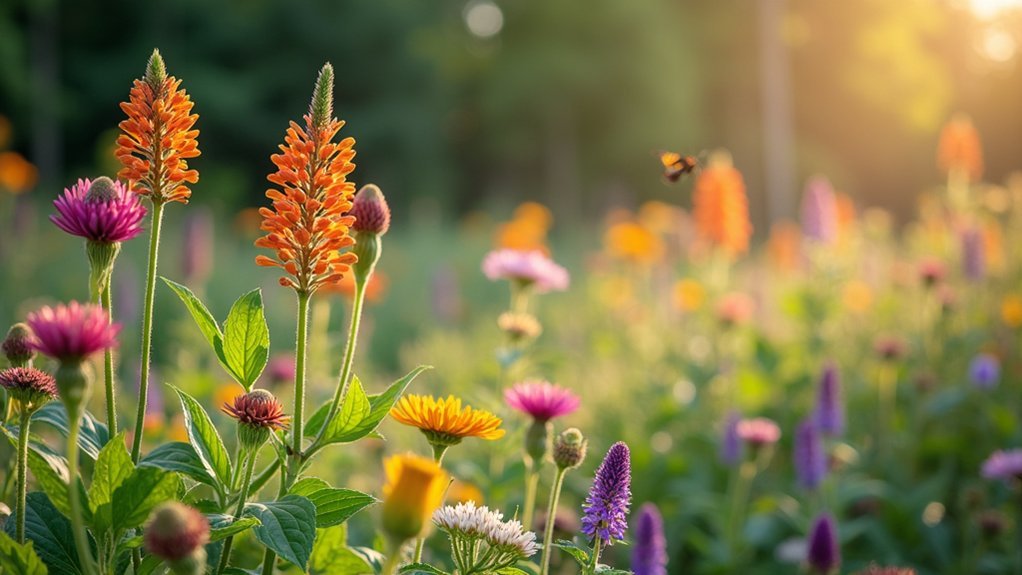
Successful butterfly gardens depend on more than just colorful nectar sources—they require specific host plants where butterflies lay eggs and feed their young.
Choose plants that support the complete lifecycle of local butterfly species. For Monarchs, milkweed is essential, while Swallowtails need parsley and fennel.
Include native trees in your border design, as many butterfly species depend on them for reproduction.
Oak, cherry, and willow trees serve as hosts for numerous caterpillar species that will eventually transform into beautiful butterflies.
For maximum diversity, combine various host plants like asters, goldenrods, and thistles with your nectar sources.
This approach creates a self-sustaining habitat where butterflies can complete their entire lifecycle—from egg-laying to adult feeding—within your garden’s boundaries.
Managing Border Maintenance Without Chemicals
Maintaining a thriving pollinator border doesn’t require synthetic chemicals or pesticides that can harm the very creatures you’re trying to attract.
By implementing natural approaches, you’ll create a healthier ecosystem for native species while keeping maintenance manageable.
Embrace these chemical-free maintenance strategies:
- Introduce beneficial insects like ladybugs and lacewings to naturally control pest populations.
- Apply organic mulch around plants to suppress weeds, retain moisture, and enrich soil as it breaks down.
- Use physical barriers such as row covers for early-season protection, removing them when plants flower.
- Regularly inspect plants for pest issues so you can intervene early with targeted non-chemical solutions.
Increasing plant diversity with native species creates a balanced ecosystem where pests are less likely to gain a foothold, reducing your need to intervene with treatments of any kind.
Balancing Aesthetics With Ecological Function
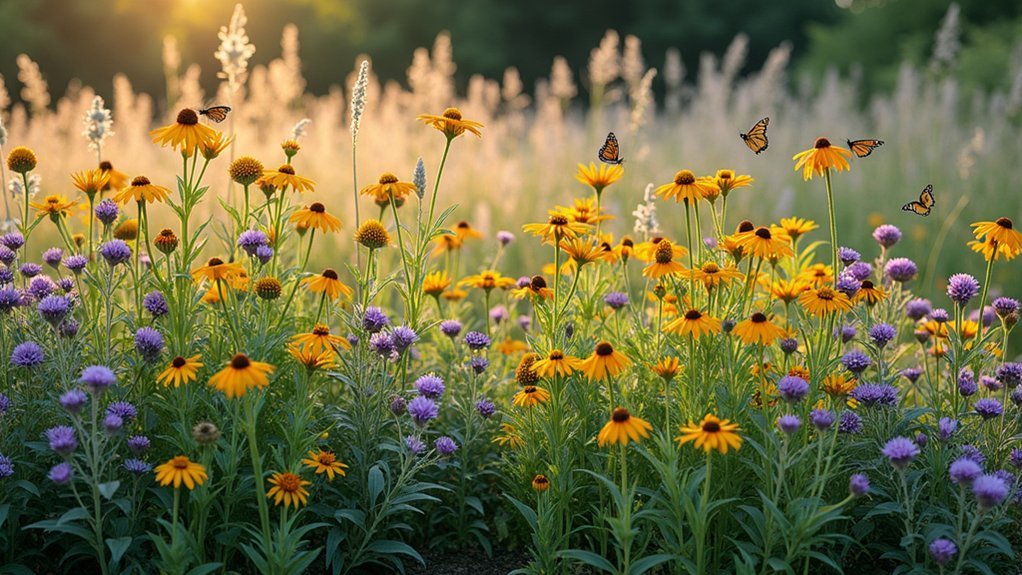
Creating beautiful gardens that also support local ecosystems doesn’t require choosing between visual appeal and environmental benefit. You can achieve both by strategically placing native plants in layers and groupings that please the eye while supporting wildlife.
Select native plants with complementary heights, textures, and bloom times to create visual interest throughout the seasons. Coneflowers and zinnias offer vibrant colors while attracting diverse pollinators. Position taller species toward the back of borders, with medium and ground-covering varieties in front for a professional, designed appearance.
Remember that ecological function enhances aesthetics rather than detracting from it. The butterflies, bees, and birds drawn to your native plant border become living ornaments, bringing movement and life to your garden while performing essential ecosystem services.
Maximizing Small Spaces for Pollinator Borders
Even the smallest garden spaces can become powerful pollinator hubs with thoughtful planning. You don’t need acres of land to make a difference—just smart strategies that maximize every inch of your compact border.
- Exploit vertical space with climbing native plants like pole beans or native vines that create habitats while growing upward.
- Layer your plantings with taller coneflowers behind shorter native flowering plants, creating visual interest while providing diverse nesting opportunities.
- Choose low-growing border plants such as creeping thyme or wild strawberries that attract pollinators without taking up much space.
- Include 5-10 different native species with staggered blooming times to guarantee continuous food sources throughout the growing season.
This strategic approach turns even tiny borders into biodiversity hotspots that support local ecosystems and pollinator populations year-round.
Connecting Your Border to the Broader Landscape
Your native plant border can serve as a crucial link in the wildlife corridors that allow pollinators to travel safely between larger habitats.
Select plants that match your region’s natural plant communities to create an authentic ecosystem that supports local species throughout their migration patterns.
Create Wildlife Corridors
While individual pollinator gardens offer valuable habitat, wildlife corridors dramatically amplify their impact by connecting these isolated oases into a functional ecosystem network.
You’ll create essential pathways for pollinators to access resources across fragmented landscapes when you extend your native plant border into a wildlife corridor.
To create effective wildlife corridors:
- Plant diverse native flowering species with staggered bloom times to provide continuous food sources throughout the growing season
- Incorporate structural elements like hedgerows and buffer strips that offer protection during migration
- Design corridors that reflect local conditions and native plant communities for maximum ecological resilience
- Connect to existing natural areas whenever possible to facilitate gene flow and strengthen pollinator populations
Your corridor doesn’t need to be massive—even modest connections between habitats can greatly boost pollinator diversity in your landscape.
Match Regional Plant Communities
The most successful pollinator borders reflect the ecological context of their surroundings, not just a collection of pretty native flowers. When you design your space to mirror local plant communities, you’re creating a functional ecosystem that seamlessly integrates with the broader landscape.
| Ecosystem Type | Native Plants | Benefits | Pollinators Supported |
|---|---|---|---|
| Woodland Edge | Serviceberry, Trillium | Shade tolerance, soil building | Bees, butterflies |
| Prairie/Meadow | Coneflower, Milkweed | Drought resistance, deep roots | Monarchs, native bees |
| Wetland Margin | Cardinal flower, Blue flag iris | Flood tolerance, filtration | Hummingbirds, moths |
| Rocky Outcrop | Penstemon, Yarrow | Low water needs, wind resistance | Mining bees, flies |
Contact local conservation districts for guidance on which native plants best represent your region’s ecological communities. These carefully matched plantings will support more diverse pollinator populations than random selections.
Consider Migration Patterns
When designed thoughtfully, native plant borders become significant waypoints in the vast networks that support migratory pollinators across continents.
Your garden can play a critical role in these migration patterns by providing essential resources at key moments.
- Select plants that bloom during Monarch butterfly migrations to offer nectar pit stops
- Create continuous corridors of native plants that align with natural migration paths
- Include flowering varieties with staggered blooming periods to support pollinators throughout their journey
- Choose regionally adapted native plants that provide familiar, nutrient-rich food sources
Frequently Asked Questions
How to Make a Native Pollinator Garden?
Plant diverse native species that bloom sequentially, group them closely, prepare healthy soil, add water sources like pebble-filled dishes, and avoid pesticides. You’ll create a thriving habitat that supports local pollinators year-round.
How Do You Layout a Pollinator Garden?
Arrange your pollinator garden in dense clusters of colorful plants that bloom throughout the season. Group by sun requirements, include water sources and nesting sites, and design accessible pathways for maintenance without disturbing plants.
What Plants Are Best for a Pollinator Garden?
Choose native flowers like coneflowers, sunflowers, zinnias, and milkweed that bloom throughout the season. You’ll want at least 26 species of pesticide-free plants to provide continuous nectar sources for diverse pollinators.
Are Native Plants Better for Pollinators?
Yes, native plants are better for pollinators. They’ve evolved with local species, providing ideal nutrition and habitat. You’ll attract more diverse pollinators with natives, and they’ll require less maintenance in your garden.
In Summary
Your native plant border isn’t just a beautiful addition to your garden—it’s a lifeline for local pollinators. By following these ten tips, you’ll create a thriving ecosystem that supports biodiversity right in your backyard. Remember, you’re not just gardening; you’re providing essential habitat. Start small, observe what works, and you’ll soon see your border buzzing with the activity of grateful pollinators.

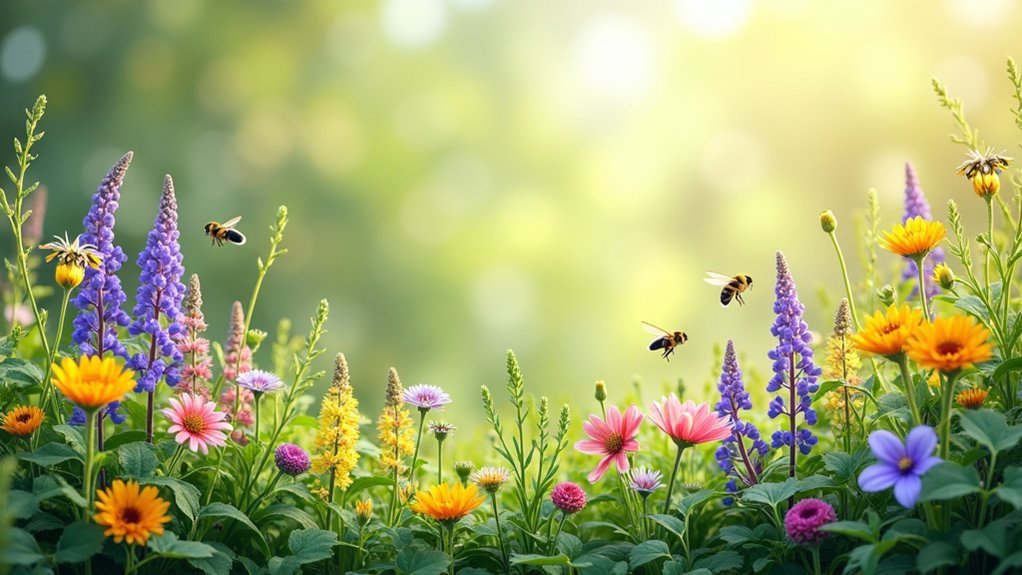



Leave a Reply